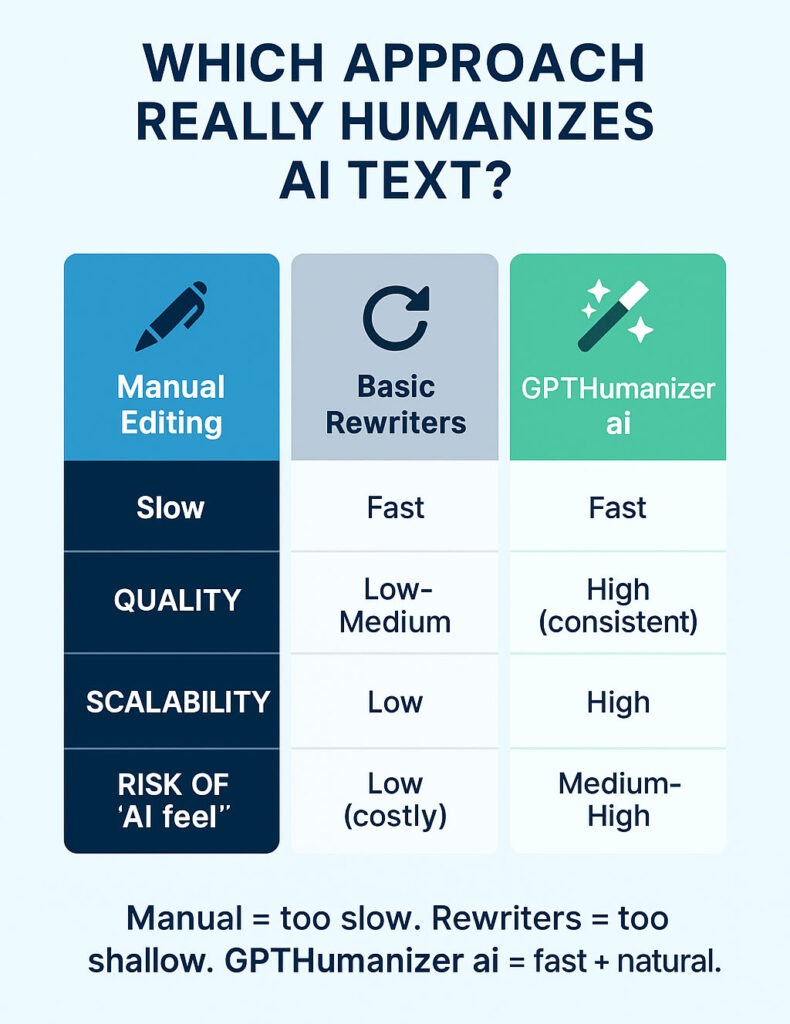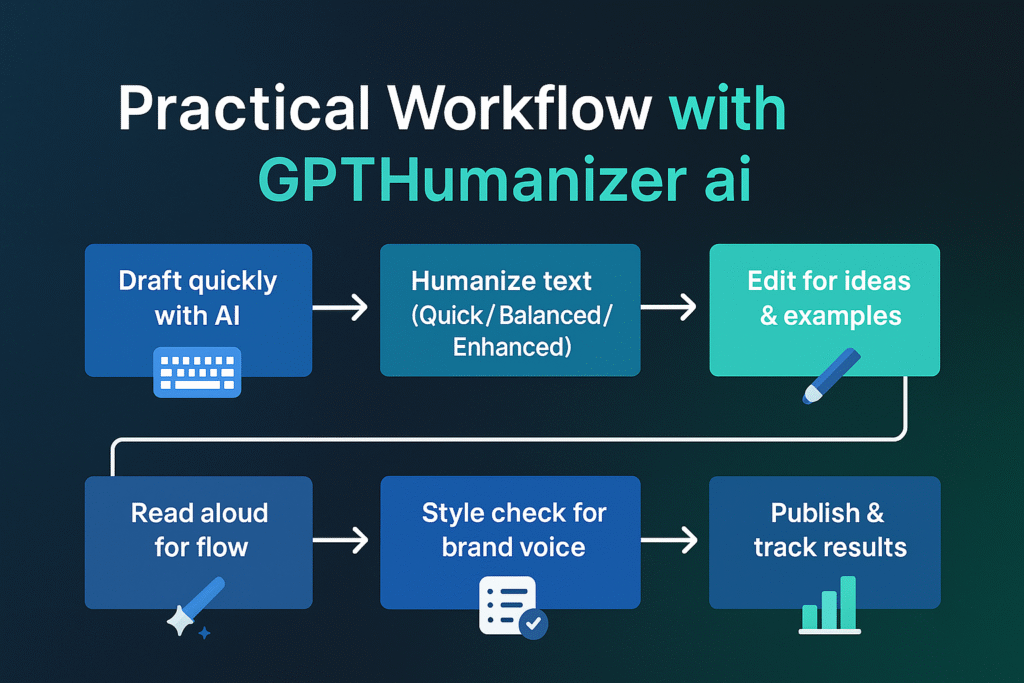
Introduction
AI writing tools can produce a thousand words in the time it takes to brew coffee. That speed is handy—but it comes with a trade-off: much of the text sounds like a machine wrote it. The tone is flat, transitions feel stitched together, and readers often bounce.
For anyone relying on content, that’s costly. SEO teams see rankings slide when engagement drops. Bloggers lose shares and returning readers. Students and researchers worry that raw drafts will trigger detection tools. In short: AI is fast, but authenticity keeps people reading.
This article explores why authenticity matters for SEO, where quick fixes usually fail, and how to build a workflow that produces natural, human-sounding content—without burning hours on edits.
Why Humanized AI Content Matters for SEO
Search engines now rely heavily on user signals. If visitors skim and leave, rankings fall. Authentic writing has the opposite effect: it holds attention, encourages shares, and builds trust.
Think of the last article you closed after three lines. The grammar was fine, but it felt mechanical—no rhythm, no voice. That’s exactly what kills dwell time and return visits. Humanized content changes the feel, which in turn improves the metrics.
It’s also about credibility. A product page, blog, or report depends on tone as much as accuracy. When the writing sounds natural, readers stay longer and engage more. That’s why many teams prioritize processes that Humanize AI early, not as an afterthought.
Common Ways to “Fix” AI Text (and Why They Fall Short)
Most teams start with one of two fixes: manual editing or rewriting tools.
- Manual editing works, but it’s slow. Polishing 1,500 words line by line—adding examples, fixing transitions, adjusting tone—can take over an hour. Scale that across a content calendar and the hours disappear.
- Basic rewriters are quick, but they only swap synonyms or shuffle sentences. The result often still feels awkward because rhythm and voice never change.
What teams really need is a middle ground: quality that scales. That’s where a dedicated humanizer comes in. Many have turned to tools like GPTHumanizer ai, designed to go beyond paraphrasing and make AI text sound genuinely natural.

How GPTHumanizer ai Makes Content Sound Human
Most rewriters focus on words. GPTHumanizer ai focuses on expression—sentence variety, smoother transitions, and plain-language phrasing that readers expect.
Modes for different needs
- Quick Mode: fast cleanup for short emails, updates, or time-sensitive posts.
- Balanced Mode: everyday blogging and SEO, balancing speed and nuance.
- Enhanced Mode: long-form or high-stakes writing, such as cornerstone blogs or academic work.
Meaning stays, style improves
- AI draft: “This tool is very useful and many people like it.”
- Humanized: “Many users find this tool genuinely helpful, and its popularity keeps growing.”
The message is the same, but the tone is smoother and more confident.
Consistency at scale
Manual edits vary with deadlines and energy. GPTHumanizer ai keeps tone steady across dozens of pieces, protecting brand voice while speeding up production.
Lower detection risk
Instead of disguising AI text, the tool restructures it into natural prose: varied sentences, cleaner flow, fewer “robotic” cues. Readers benefit, and compliance checks are less likely to flag it.
Who Benefits Most (with scenarios)
- Bloggers & publishers
Need consistent output without losing tone. Humanized posts keep readers longer, boosting search metrics.
Example: One weekly publisher saw “time on page” climb by ~25% after humanizing intros and transitions. - SEO & marketing teams
Helpful content works only when readers sense a real voice. Humanized copy improves engagement, click-throughs, and even sign-ups.
Example: A SaaS team humanized product pages and saw demo requests rise—same features, clearer voice. - Freelance writers
Clients can spot “AI tone” immediately. A humanizer helps deliver polished drafts quickly so you can focus on ideas. - Students & researchers
Natural phrasing reduces red flags in academic workflows and makes arguments easier to follow. - Corporate teams
From product pages to onboarding guides, maintaining a consistent voice at scale is hard manually. A humanizer makes it easier.
Manual vs. Tools vs. Dedicated Humanizer
| Approach | Voice Quality | Speed | Scalability | Risk of “AI feel” |
|---|---|---|---|---|
| Manual editing | High (variable) | Low | Low | Low (but costly) |
| Basic rewriter/paraphrase | Low–Medium | High | High | Medium–High |
| Dedicated humanizer | High (consistent) | High | High | Low |
Takeaway: A dedicated humanizer combines manual-level quality with tool-level speed.
Long-Term Value
1. Time and cost savings
What takes hours manually is reduced to minutes. Over weeks, that’s a full workday saved.
2. Consistency builds trust
A uniform voice makes your brand memorable. Readers should feel one writer, not five.
3. SEO gains that last
Natural writing improves dwell time and shareability—the silent metrics that stabilize rankings.
4. Lower compliance risk
Clear, human-like prose avoids awkward AI cues that trigger detection.
5. A repeatable process
Instead of patching drafts from scratch, you follow a loop: draft → humanize → quick edit → publish → measure → refine.
Practical Tips for Best Results
- Outline first → Focus on structure, then humanize.
- Pick the right mode → Quick, Balanced, or Enhanced depending on the task.
- Edit for substance → Add examples or sharper claims after humanizing.
- Read aloud → If it sounds clunky out loud, fix it.
- Track results → Measure dwell time, scroll depth, and conversions to prove the lift.

Section 8: FAQ
Q1: Will humanizing erase my brand voice?
No. It removes robotic phrasing but leaves space for your own tone and style.
Q2: Why not just use a paraphraser?
Paraphrasers change words, not rhythm. Readers still notice stiffness. A humanizer improves flow.
Q3: Is “humanizing for SEO” risky?
Not at all. SEO rewards clarity and engagement—exactly what humanization provides.
Q4: Where does the humanizer fit in my workflow?
Draft with AI → humanize → edit for ideas → publish → measure. Keep it consistent.
Conclusion & Next Step
AI speeds up drafting, but speed alone doesn’t win trust—or rankings. Success comes from writing that sounds human: sentences with rhythm, transitions that carry readers forward, and examples that resonate.
That’s the promise of a dedicated humanizer. It blends manual-grade voice with tool-grade speed, so you can scale without sounding robotic.
If you want to hear the difference yourself, run your next draft through GPTHumanizer ai and compare it to the original. You’ll notice the flow, warmth, and readability right away. Build that into your process, and your content won’t just grow—it’ll perform.



